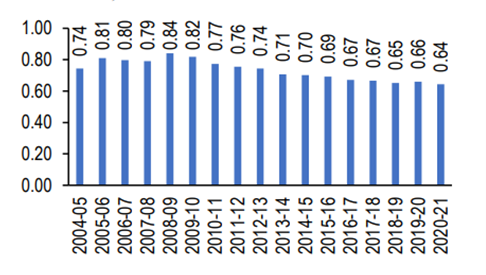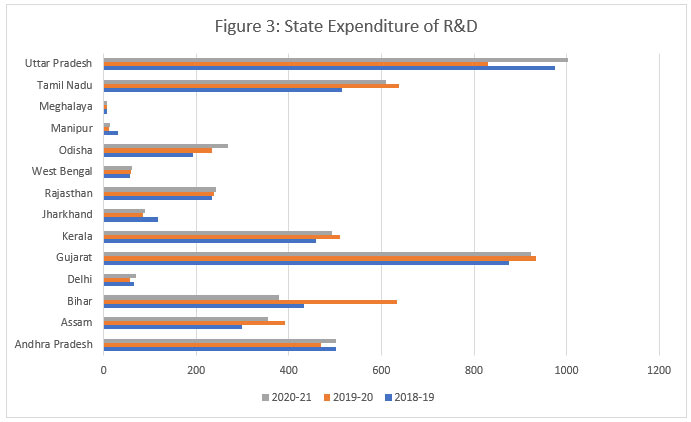-
CENTRES
Progammes & Centres
Location
India’s research ecosystem is gaining momentum, but it is still highly concentrated. Anusandhan National Research Foundation’s success depends on whether it can democratise innovation – not just fund it.

Image Source: Getty Images
India has recorded five consecutive years of double-digit growth in innovation indicators, with a solid 7.6 percent increase in research output, an encouraging sign of domestic momentum. In the Global Innovation Index 2025, India ranks first among the lower-middle-income economies and the Central and South Asian region. Yet, the country's overall innovation ecosystem continues to underperform when measured against regional peers such as China, the Republic of Korea, and Singapore—countries alongside which it wants to position itself.
The National Education Policy (NEP) 2020 has placed research and innovation at the heart of educational reform. It envisioned a future where India would emerge as a global hub for knowledge creation and problem-solving. From school education to higher education, NEP emphasises inquiry-based learning to create a culture of curiosity and critical thinking for future researchers. Other areas of focus included breaking down rigid disciplinary silos, fostering problem-based learning, and nurturing innovation across STEM (Science, Technology, Engineering, and Mathematics), social sciences, and humanities. It also aims to promote partnership between academia, industry, and international institutions to expand research ecosystems. To advance this vision, Anusandhan National Research Foundation (ANRF) was established as an apex body to fund, mentor, and promote cutting-edge research across disciplines.
ANRF is an independent body under the Ministry of Science and Technology, with representation from academia, industry, and government.
ANRF’s goal is to bridge funding gaps, promote innovation with a pan-India focus, catalyse collaboration among stakeholders, build capacities of institutions and researchers, and support strategic research in critical sectors effectively. ANRF is an independent body under the Ministry of Science and Technology, with representation from academia, industry, and government. For the fiscal year 2024–25, the government allocated INR 966 crore (revised estimate) to the ANRF, which has been used for several key initiatives and programmes, such as the Prime Minister (PM) Professorship Programme, Partnerships for Accelerated Innovation and Research (PAIR), Inclusivity Research Grant (IRG) scheme, the PM Early Career Research Grant, and JC Bose Grant.
Nonetheless, five years since NEP’s release and nearly two years after the ANRF Act, the promise to create a research and innovation-driven ecosystem and its progress have been uneven. Despite improvements in global rankings and the presence of acclaimed institutions such as the Indian Institute of Technology (IITs), Indian Institute of Management (IIMs), and Indian Institute of Science (IISc), there are several key gaps in India's innovation system, such as institutional quality, market sophistication, equitable opportunities, and industry-academia collaboration.
The gross expenditure on research and development (GERD) has been consistently increasing over the years, more than doubling from INR 60,196.75 crore in 2010–11 to INR 127,380.96 crore in 2020–21. However, in terms of percentage of the Gross Domestic Product (GDP), it has stagnated between 0.6 and 0.8 percent, which is below the global average (Figure 1).
Figure 1: GERD as a percentage of GDP

Source: PRS Legislative Research, 2024-25
Compared to regional peers such as Singapore, South Korea, and China, India continues to struggle in infrastructure, human capital, research, and business sophistication. Its relative strengths in knowledge creation (Rank 22) suggest strong potential; however, they need to be supported through R&D funding, institutional quality, and linkages between academia and business to develop its ecosystem completely. (see table 1).
Table 1: Rankings on innovation Indicators: India and Emerging Economies (2025)
| Country | Overall Global Innovation Index rank | Institutions | Human capital and research | Infrastructure | Market sophistication | Business sophistication | Knowledge and technology outputs | Creative outputs |
| Singapore | 5 | 1 | 2 | 19 | 6 | 3 | 7 | 15 |
| Republic of Korea | 4 | 20 | 1 | 7 | 5 | 4 | 9 | 4 |
| China | 10 | 44 | 20 | 6 | 13 | 8 | 1 | 14 |
| India | 38 | 58 | 54 | 61 | 38 | 64 | 22 | 42 |
Source: World Intellectual Property Organisation (WIPO), 2025
Over the last three years, India has moved up its ranks from 40 (2023) to 39 (2024) and further to 38 (2025), showing gradual improvement; however, pillar-wise analysis reveals some stagnation or decline (Table 2).
Table 2: India: Rankings on Innovation Indicators for the past three years
| Country | Overall Global Innovation Index rank | Institutions | Human capital and research | Infrastructure | Market sophistication | Business sophistication | Knowledge and technology outputs | Creative outputs |
| 2025 | 38 | 58 | 54 | 61 | 38 | 64 | 22 | 42 |
| 2024 | 39 | 54 | 51 | 72 | 23 | 58 | 22 | 43 |
| 2023 | 40 | 56 | 48 | 84 | 20 | 57 | 22 | 49 |
Source: World Intellectual Property Organisation (WIPO), 2025, 2024 and 2023
If the rankings of the past three years are compared, infrastructure has indicated steady improvement, increasing in rank from 84 in 2023 to 72 in 2024 and then 61 in 2025. However, market sophistication, suggesting credit, investments, trade, and market diversification, has declined sharply from 20 (2023) to 38 (2025). Ranking in human capital and research has dropped from 48 in 2023 to 51 in 2024 to 54 in 2025, indicating challenges in education and research investment. Institution rankings have regressed from 54 (2024) to 58 (2025), reflecting persistent challenges in the regulatory and policy environment. Creative outputs have shown marginal improvements, and knowledge and technology outputs have remained stable and relatively strong at 22. WIPO notes that India’s creative output has grown in quantity but not in quality. A large share of publications is in lower-impact journals, reducing visibility and impact; while the patent filings remain modest, despite an increase. Overall, there is a mixed trend in India’s state of innovation, with data indicating a need to address specific sectoral weaknesses of human capital, business sophistication, and institutional reforms.
Research is concentrated in a handful of elite institutions: the top 19 institutions (18 IITs and IISc Bengaluru), which account for 28.70 percent of India’s research publications and 30.84 percent of citations, according to the India Rankings Report 2025.
Within the country, research is concentrated in a handful of elite institutions: the top 19 institutions (18 IITs and IISc Bengaluru), which account for 28.70 percent of India’s research publications and 30.84 percent of citations, according to the India Rankings Report 2025. This highlights a concentration of quality research among the highest-ranked institutions, with the majority of Tier 2 and Tier 3 institutions remaining teaching-focused, with little emphasis on inquiry or innovation.
Inter-state disparities remain high. Northeast and Eastern states (Manipur, Meghalaya, West Bengal, Odisha, and Jharkhand) have consistently seen low investments in R&D (see figure 3).

Source: Rajya Sabha Starred Question No. 132, Answered On 31.07.2025
Indian industry relies significantly on imported technologies, with limited domestic investments in R&D. This results in two consequences: first, it reduces the incentive for private firms to build in-house R&D capacities, leading to reliance on public funding. It is estimated that private sector investment in R&D in India is only around 36 percent, compared to 70 percent in countries such as China and South Korea. Second, this results in the absence of strong technology-transfer ecosystems between academia and industry, causing university research to focus on theoretical or academic pursuits with limited practical application or commercialisation potential.
Although the operationalisation of the ANRF marks a significant step toward enhancing India's research ecosystem, its success will depend on the strategic distribution of resources, effective governance, and industry buy-in.
Although the operationalisation of the ANRF marks a significant step toward enhancing India's research ecosystem, its success will depend on the strategic distribution of resources, effective governance, and industry buy-in. Accordingly, given below are four specific recommendations to strengthen ANRF’s impact:
First, India must strive to increase R&D investment to 1.5 percent of GDP by 2030, with a focus on boosting public funding, particularly in priority areas. Incentivising private sector contributions through tax breaks, co-funding schemes, and innovation-linked subsidies must be explored. A 10-year ‘National R&D Bond’ that mobilises investment from the global Indian diaspora and channels it into homegrown research initiatives could be created.
Second, ANRF funding must be monitored and allocated transparently and equitably across institutions to democratise research. Focus must be on providing seed grants, labs, and mentorship to state-level universities and colleges. ANRF should establish regional innovation clusters to connect local universities with industries and communities, and encourage research at undergraduate and master’s levels, not only for PhDs. Its outcomes must include high-impact publications, patents, startups, and policy solutions.
Third, there is an urgent need to strengthen the research-to-market pipeline by establishing joint R&D centres with co-investment from corporations and universities, and tax credits tied to commercialisation outcomes. Regular collaboration platforms must be cultivated through workshops, seminars, and innovation challenges, which can foster ongoing dialogue and idea exchange.
Fourth, it is crucial to build human capital for research. Focused faculty training in inquiry-based pedagogy and research methods, attracting global Indian researchers to return through fellowships, competitive salaries, and lab autonomy and integrating mandatory research internships into higher education curricula are some ideas in this direction.
If India is to reap the dividends of having the world’s largest young population, it must channel talent into innovation and problem-solving rather than rote-based learning.
India’s ambition to become a US$5 trillion economy depends on a strong research base that can drive industrial competitiveness, productivity, and job creation. Building indigenous capacity in areas such as semiconductors, Artificial Intelligence (AI), renewable energy, defence, and other such domains that can reduce dependence on foreign technology, fostering self-reliance. Furthermore, social impact sectors including health, nutrition and agriculture directly contribute to addressing poverty, inequality, and climate challenges. Therefore, if India is to reap the dividends of having the world’s largest young population, it must channel talent into innovation and problem-solving rather than rote-based learning.
The NEP 2020 and the ANRF Act have set a bold agenda for embedding research and innovation into the heart of India’s education and development. However, sustained efforts, systemic reforms and collaborative partnerships will be crucial to realising the full potential of this initiative.
Arpan Tulsyan is a Senior Fellow at the Centre for New Economic Diplomacy, Observer Research Foundation.
The views expressed above belong to the author(s). ORF research and analyses now available on Telegram! Click here to access our curated content — blogs, longforms and interviews.

Arpan Tulsyan is a Senior Fellow at ORF’s Centre for New Economic Diplomacy (CNED). With 16 years of experience in development research and policy advocacy, Arpan ...
Read More +